Jackie:
It’s good to be back on this blog this month. We took a necessary break, but cannot be away from talking about books for too long. The pressure builds…
Phyllis is busy writing in the North Woods, so I am bee-side myself with enthusiasm for doing this blog.
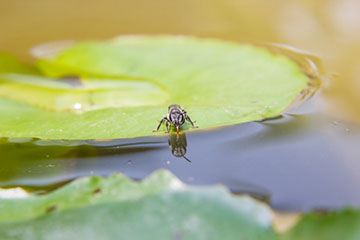
We have a make-shift birdbath on our deck, next to our hummingbird and oriole feeders, and this summer the bees have found the bird bath. I guess I never asked myself if bees got thirsty but the answer is yes. And I have loved watching them lean in from the edge of the birdbath and grab a drink of water.
And that has put me in mind of some favorite “bee” books.
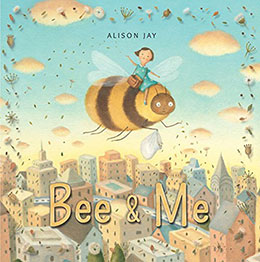 First, a big challenge for a picture book writer — discussing in words a wordless picture book. But I must try. I love this book—Bee and Me by Alison Jay — so much. And I know Phyllis does, too. It’s not an old book but new this year. The story begins with a city, where there are many tall buildings, lots of cars and three trees. The next spread closes in on a apartment house and an approaching bee. When the bee flies in the window of one apartment, the girl who lives there is frightened and gets a swatter. She traps the bee, who passes out. The girl then reads about bees and feeds the bee some sugar water. The bee flies off, into a terrible rainstorm, then drenched, shows up on the windowsill again. A hair dryer and more sugar water later, the bee has grown. And a series of small vignettes in the next spread show the bee growing big enough to sit in a basket, go on a picnic, ride a bike, even stroll past a flower shop. The bee gives the girl a ride (much bigger now) out into the country, where they gather seeds. They return to the city and sow the seeds from the sky. The bee leaves for the winter. On the next to the last page spring has come and with it flowers, green roofs all over the city, people outside on bicycles, dancing, strolling. On the last page, the bee has returned and the girl, a new kid friend, and the bee run through the bird and flower- filled city landscape. This book covers so much ground — from barren landscape to Eden, from bee-fright to bee-friendship. And I haven’t even mentioned the wonderful details of city life within the illustrations. Readers who want more information about plants good for bees and other bee-friendly activities will find the endpapers a great starting pace.
First, a big challenge for a picture book writer — discussing in words a wordless picture book. But I must try. I love this book—Bee and Me by Alison Jay — so much. And I know Phyllis does, too. It’s not an old book but new this year. The story begins with a city, where there are many tall buildings, lots of cars and three trees. The next spread closes in on a apartment house and an approaching bee. When the bee flies in the window of one apartment, the girl who lives there is frightened and gets a swatter. She traps the bee, who passes out. The girl then reads about bees and feeds the bee some sugar water. The bee flies off, into a terrible rainstorm, then drenched, shows up on the windowsill again. A hair dryer and more sugar water later, the bee has grown. And a series of small vignettes in the next spread show the bee growing big enough to sit in a basket, go on a picnic, ride a bike, even stroll past a flower shop. The bee gives the girl a ride (much bigger now) out into the country, where they gather seeds. They return to the city and sow the seeds from the sky. The bee leaves for the winter. On the next to the last page spring has come and with it flowers, green roofs all over the city, people outside on bicycles, dancing, strolling. On the last page, the bee has returned and the girl, a new kid friend, and the bee run through the bird and flower- filled city landscape. This book covers so much ground — from barren landscape to Eden, from bee-fright to bee-friendship. And I haven’t even mentioned the wonderful details of city life within the illustrations. Readers who want more information about plants good for bees and other bee-friendly activities will find the endpapers a great starting pace.
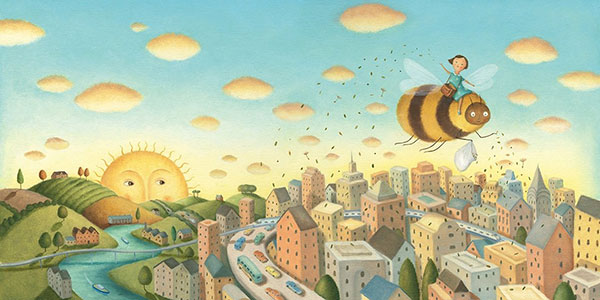
Now for a different kind of challenge, writing about a book I used to love. I remember reading with fondness several decades ago The Bee-Man of Orn by 19th century American writer Frank Stockton. The version I know was illustrated by Maurice Sendak and published in 1964. The Bee-Man is a happy man who lives with his bees.
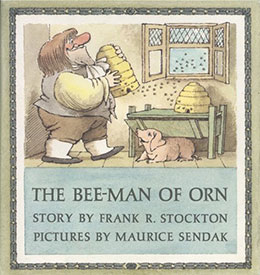 He is completely contented in his simple life — until a Junior Sorcerer comes along and assures the Bee-Man that he has been transformed and that, for sure, he should be changed back to whatever he used to be. And then the Junior Sorcerer goes on his way. The Bee-Man, curious (“I have an honest desire to become what I originally was.”) goes out to discover what he originally was.
He is completely contented in his simple life — until a Junior Sorcerer comes along and assures the Bee-Man that he has been transformed and that, for sure, he should be changed back to whatever he used to be. And then the Junior Sorcerer goes on his way. The Bee-Man, curious (“I have an honest desire to become what I originally was.”) goes out to discover what he originally was.
He meets a Lord of the Manor, who looks attractive until he kicks the Bee-Man, a Languid Youth, and rescues a baby from a dragon. When he sees the baby he decides he must have been transformed from a baby. “…by magic arts the Bee-Man was transformed into a baby and raised by the grateful mother of the baby he saved. Years later, the Junior Sorcerer, now a very Senior Sorcerer, passes the old house of the Bee-Man, only to find the baby has grown into the Bee-Man of Orne.
I love Maurice Sendak’s illustrations of the contented Bee-Man, fierce griffins and dragons. I love the theme of the story. We are what we are — and that is okay. Be yourself and that’s okay. And the gentle kindness of the Bee-Man, who says he would never kick a poor old man, who tries to help the Langorous Youth, and shows uncharacteristic ferocity with the dragon to save a baby.
Someone said we can never step in the same river twice. We never read the same book twice. We change. What we notice and are disturbed by changes. I was disappointed this time to notice the Very Imp, who stands at the entrance of cave that holds the dragon and the griffin “resembles in color a freshly polished pair of boots.” Why does the Very Imp have to be dark-skinned? Why not green, or orange? And what does it say about the nineteenth century that the Very Imp is the color of a pair of boots. He’s not evil. Still, I feel that Stockton was once more playing into that old meme of untrustworthiness related to skin color. Some may say I’m too sensitive here, but when I look around at our culture right now, I think anything that contributes to old but still living stereotypes, reveals old but still intense prejudices, must be objected to. If I could re-write this story and make the Very Imp the same complexion as the Bee Man, I would.
This book might be good for discussions with older kids as part of a unit on the subtle messages our stories give us. And there are Maurice Sendak’s wonderful illustrations. But it’s not the book I thought it was.
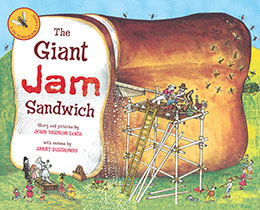 Finally, not bees but flying insects, are important in another favorite—Giant Jam Sandwich by Janet Burroway and John Vernon Lord. What are the people of Itching Downs to do when a swarm four million wasps flies into town? “They drove the picnickers away,/They chased the farmers from their hay,/ They stung Lord Swell on his fat bald pâté,/They dived and hummed and buzzed and ate.” When Bap the Baker suggests a giant jam sandwich they all pitch in and eventually get rid of the pests. This story is so much fun. Burroway’s wonderful rhymes pull us along as we watch the community working together to get rid of the pests and celebrating together their successful venture. I never tire of the sound of this story or idyllic village where everyone can work together.
Finally, not bees but flying insects, are important in another favorite—Giant Jam Sandwich by Janet Burroway and John Vernon Lord. What are the people of Itching Downs to do when a swarm four million wasps flies into town? “They drove the picnickers away,/They chased the farmers from their hay,/ They stung Lord Swell on his fat bald pâté,/They dived and hummed and buzzed and ate.” When Bap the Baker suggests a giant jam sandwich they all pitch in and eventually get rid of the pests. This story is so much fun. Burroway’s wonderful rhymes pull us along as we watch the community working together to get rid of the pests and celebrating together their successful venture. I never tire of the sound of this story or idyllic village where everyone can work together.
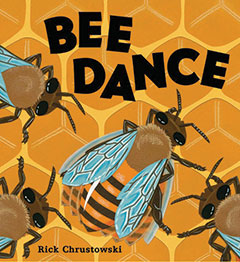 Phyllis has told me of a very well-reviewed “bee book” by a Minnesotan, which I have not been able to find in time for this column, but I hope you can: Bee Dance by Rick Chrustowski, published by Henry Holt, 2015.
Phyllis has told me of a very well-reviewed “bee book” by a Minnesotan, which I have not been able to find in time for this column, but I hope you can: Bee Dance by Rick Chrustowski, published by Henry Holt, 2015.
We have the bees and other buzzers with us for a few more weeks. Let’s enjoy them. And here are other worthy bee books:
Ang, Karen. Inside the Bees’ Hive. New York: Bearport Publishing, 2014.
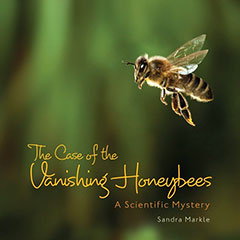 Markle, Sandra. Outside and Inside Killer Bees. New York: Walker and Company, 2004.
Markle, Sandra. Outside and Inside Killer Bees. New York: Walker and Company, 2004.
_____________ The Case of the Vanishing Honeybees A Scientific Mystery. Minneapolis: Millbrook Press, 2014.
Mortensen, Lori (illustrated by Cris Arbo). In the Trees, Honey Bees. California: Dawn, 2009.
Polacco, Patricia. The Bee Tree. New York: Philomel, 1993.

Our granddaughter LOVES Bee and Me. She reads it while I drive her home after school, poring over the drawings. Like you, I’ve noticed bees drinking from my birdbath this summer, for the first time (or maybe I didn’t pay attention in previous years?). People are slowly becoming more aware of bees and the need to protect them. The USPS “Protect the Pollinator” stamps are in high demand. Thanks for this lovely post!
My grandkids are terrified of bees. Now I know the antidote – a good book, as hoped! Thanks for the great titles, Jackie.